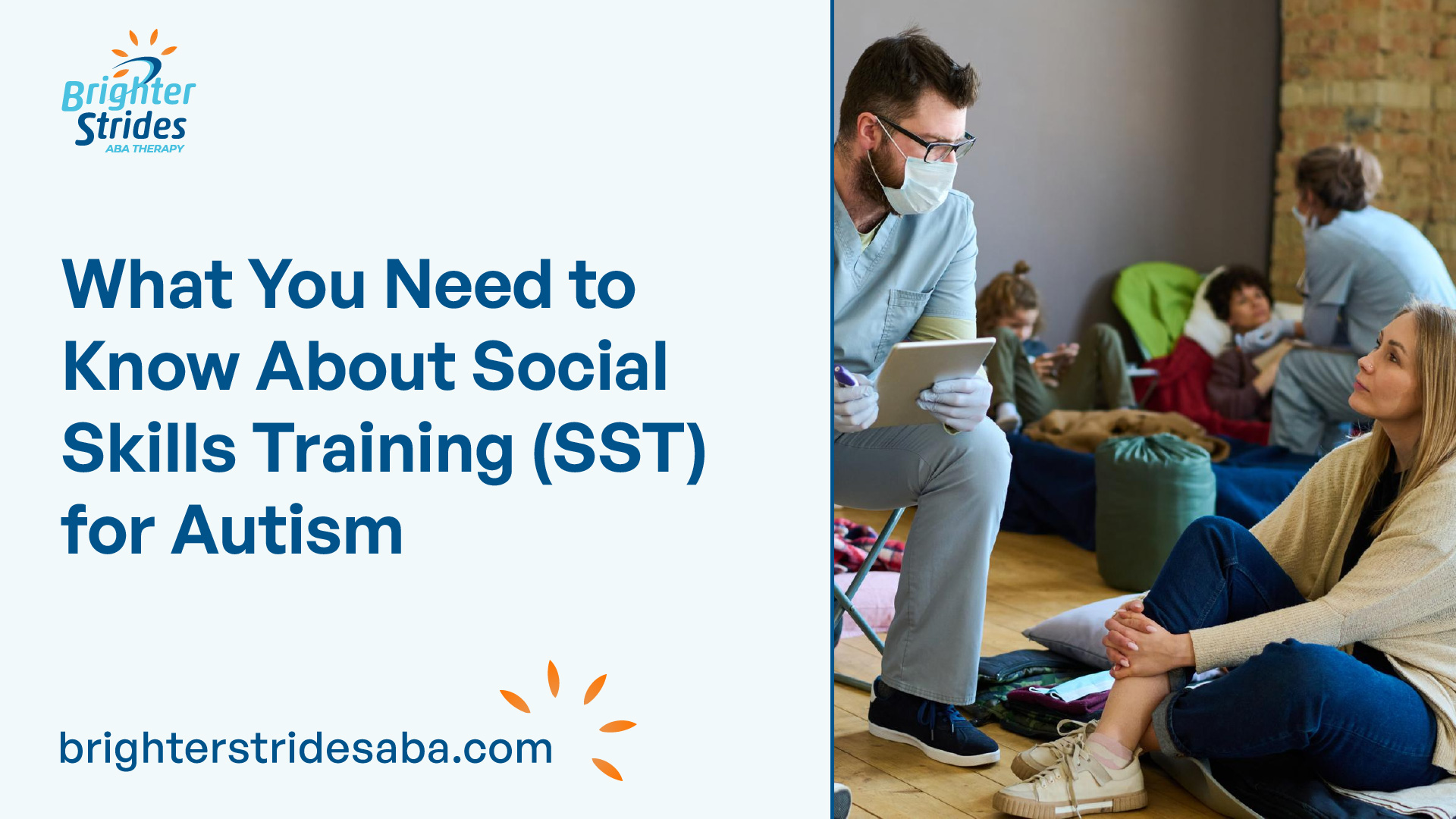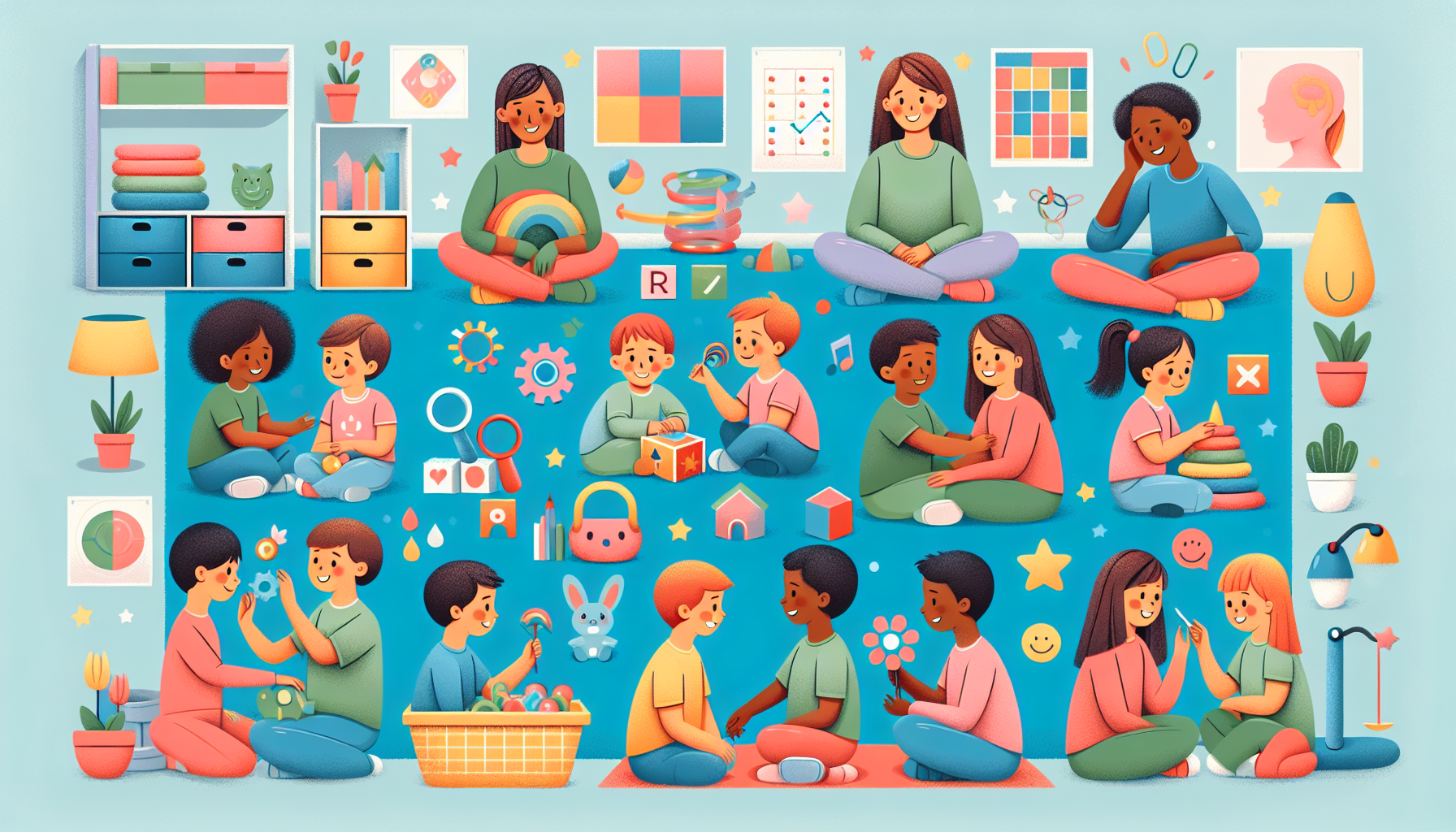Understanding Social Skills Training
Social Skills Training (SST) for autism is a therapy designed to help individuals with Autism Spectrum Disorder (ASD) develop the necessary social skills to interact with others in a positive and meaningful way [1]. Autism, also known as Autism Spectrum Disorder (ASD), is a neurodevelopmental disorder that affects social interaction, communication, and behavior.

Definition and Purpose
Social Skills Training (SST) aims to enhance the social functioning and overall quality of life for individuals with autism. The therapy focuses on teaching specific skills that are crucial for successful social interactions. These skills include but are not limited to:
- Initiating and maintaining conversations
- Understanding non-verbal cues
- Developing empathy
- Practicing appropriate social behavior in various settings
- Building and maintaining friendships
The ultimate goal of SST is to help individuals with autism navigate social situations more effectively, fostering positive relationships and increasing their sense of belonging within their social environment.
Importance of Social Skills for Individuals with Autism
Individuals with autism often face challenges in social interaction and communication, repetitive behaviors, and sensory sensitivities. Difficulties in social skills can lead to feelings of isolation, frustration, and limited opportunities for meaningful connections. SST addresses these challenges by providing individuals with the tools and strategies necessary to navigate social interactions successfully.
By developing social skills, individuals with autism can experience a range of benefits, including:
- Improved communication and language abilities
- Enhanced self-esteem and self-confidence
- Increased independence and self-advocacy
- Better understanding of social norms and expectations
- Greater opportunities for social inclusion and participation
SST plays a crucial role in empowering individuals with autism to lead fulfilling lives and establish meaningful connections with others. It equips them with the skills needed to navigate the social complexities of everyday life and build relationships based on mutual understanding and respect.
Traditional vs. Technological Approaches
When it comes to social skills training (SST) for individuals with autism, there are two primary approaches: traditional face-to-face (F2F) training and behavioral intervention technologies (BITs) utilizing computer-based programs, avatars, and therapeutic robots.
Face-to-Face Social Skills Training
Face-to-Face Social Skills Training (F2F-SST) has long been the traditional method of providing social skills interventions for individuals with autism. F2F-SST involves structured group sessions where individuals with autism learn and practice social skills with their peers under the guidance of a trained clinician.
Studies have shown that F2F-SST can be effective in improving social competence, friendship quality, and reducing loneliness in children with autism. The effect sizes for F2F-SST interventions have been in the medium range, indicating a moderate improvement in social skills.
Behavioral Intervention Technologies for SST
In recent years, there has been a growing interest in utilizing Behavioral Intervention Technologies (BITs) for delivering SST to individuals with autism. BITs-SST utilizes computer-based programs, avatars, and therapeutic robots to provide social skills training.
Research comparing F2F-SST and BITs-SST interventions for youth with autism found no significant differences in effectiveness between the two approaches. The effect sizes for both F2F-SST and BITs-SST interventions were consistently in the medium to high range, indicating a significant improvement in social skills for both approaches.
BITs-SST interventions offer several advantages, including the reduction of anxiety caused by social interactions, the ability to practice in virtual contexts, and the potential to increase access to treatment at more convenient times and for a lower cost. Additionally, BITs-SST can provide a practical solution for families facing barriers to accessing F2F-SST, such as the need for transportation and time-intensive training.
It’s important to note that while BITs-SST shows promise, further research and evaluation are needed to fully understand its effectiveness and suitability for different individuals with autism. The limited number of BITs-SST studies and the smaller overall sample size compared to F2F-SST studies currently limit the generalizability of the findings.
By considering both traditional F2F-SST and emerging BITs-SST approaches, individuals with autism and their families can explore the options that best suit their needs and preferences for social skills training.
Effectiveness of SST for Autism
Social Skills Training (SST) has proven to be an effective intervention for individuals with autism spectrum disorder (ASD). By specifically targeting social skills deficits, SST aims to enhance social competence and improve relationships. Let’s explore the impact of SST on social skills improvement and its role in enhancing social competence and relationships.
Impact on Social Skills Improvement
Both traditional face-to-face SST interventions and newer Behavioral Intervention Technologies (BITs-SST) have shown significant improvement in social skills for children and adolescents with ASD compared to control groups. Traditional SST interventions involve direct interaction with a therapist, while BITs-SST interventions utilize computer-based programs, avatars, and therapeutic robots to target social skills deficits.
Studies indicate that both face-to-face SST and BITs-SST interventions result in significant improvements in social skills for individuals with ASD. Preliminary analyses have shown no significant differences between the two approaches, with effect sizes consistently in the medium to high range. This suggests that both traditional and technological approaches are effective in enhancing social skills for individuals with autism.
Enhancing Social Competence and Relationships
Social skills training programs go beyond improving specific skills. They also aim to promote the acquisition and performance of social skills, enhance existing skills, and facilitate the generalization of skills across settings and individuals. Children with autism who receive SST demonstrate positive changes in their overall social skills, including improvements in social reciprocity and social participation.
Moreover, SST interventions have been shown to lead to modest gains in social competence, better friendship quality, and reduced loneliness in children with autism. By developing social skills and improving social interactions, individuals with autism can experience enhanced social competence and establish more meaningful relationships.
By recognizing the effectiveness of SST in improving social skills and enhancing social competence and relationships, individuals with autism can benefit from targeted interventions that address their unique social challenges. Whether through face-to-face SST or BITs-SST, these programs offer valuable support to individuals with ASD, empowering them to navigate social situations with confidence and build fulfilling connections with others.
Components of SST Programs
Social Skills Training (SST) programs for individuals with autism are designed to enhance communication, social interaction, and overall social competence. These programs consist of several key components that work together to create a structured and individualized approach to address the unique social challenges faced by individuals on the autism spectrum.
Assessment and Individualized Planning
Assessment and individualized planning are crucial steps in SST programs. A comprehensive assessment is conducted to identify the specific social skills that need improvement and to understand the individual’s strengths and challenges. This assessment may involve direct observation, interviews, and standardized assessments. Based on the assessment results, an individualized plan is developed to target the specific social skills that require attention.
The individualized plan takes into account the person’s age, developmental level, and personal goals. It outlines the specific social skills to be addressed, the strategies and techniques to be used, and the expected outcomes. Individualized planning ensures that the SST program is tailored to the unique needs of each individual.
Skill Building and Practice
Once the assessment and individualized plan are in place, the skill-building phase of the SST program begins. This phase focuses on teaching specific social skills and strategies through structured and systematic instruction. Various evidence-based techniques are employed to facilitate skill acquisition and practice.
Skill-building activities may include role-playing, video modeling, and verbal instruction. These activities provide individuals with opportunities to learn and practice appropriate social behaviors, such as initiating conversations, maintaining eye contact, and taking turns in a conversation. The aim is to develop a repertoire of social skills that can be applied in real-life social situations.
Generalization and Maintenance
The final component of SST programs is generalization and maintenance. Generalization refers to the ability to use the newly acquired social skills in different settings and with different individuals. This stage focuses on promoting the transfer of learned skills from the therapy environment to real-life social situations.
Generalization strategies may involve practicing social skills in naturalistic settings, such as community outings or social events. The goal is to ensure that individuals can apply their social skills across various contexts and with different peers. Additionally, maintenance strategies are implemented to help individuals retain and continue to use the social skills over time.
By incorporating assessment and individualized planning, skill building and practice, and generalization and maintenance, SST programs provide a comprehensive approach to improving social skills in individuals with autism. These components work together to create a structured and individualized program that addresses the unique social challenges faced by individuals on the autism spectrum.
Techniques in Social Skills Training
To effectively enhance social skills and communication abilities in individuals with autism, Social Skills Training (SST) incorporates various techniques. Among the commonly used techniques are Social Stories and Scripts, Role-Playing and Modeling, and Visual Supports and Cue Cards.
Social Stories and Scripts
Social Stories and Scripts are valuable tools in SST for autism. These techniques provide individuals with autism with concrete examples and structured narratives that help them understand social situations, learn appropriate behaviors, and navigate social interactions more effectively. Social Stories use descriptive and supportive language to outline specific social scenarios, while Scripts provide scripted dialogue for various social situations. By utilizing these tools, individuals with autism can enhance their understanding of social expectations and develop appropriate responses.
Role-Playing and Modeling
Role-Playing and Modeling are interactive techniques that enable individuals with autism to practice social skills in a safe and structured environment. Role-Playing involves simulating social scenarios, where individuals can take on different roles and engage in social interactions. This technique allows them to experiment with different approaches, practice appropriate behaviors, and receive feedback from therapists or peers. Modeling, on the other hand, involves observing and imitating appropriate social behaviors demonstrated by others. By observing positive role models, individuals with autism can learn and emulate appropriate social skills, leading to improved social interactions.
Visual Supports and Cue Cards
Visual Supports and Cue Cards provide individuals with autism with visual prompts and aids to enhance their understanding of social situations and promote appropriate social behaviors. Visual Supports can include visual schedules, social scripts, and social behavior charts that provide clear and explicit instructions. They offer individuals with autism a visual framework to follow, helping them navigate social expectations and manage their behavior effectively. Cue Cards are portable visual tools that offer reminders and prompts for specific social skills. These cards can be personalized to address individual needs and provide individuals with autism with tangible cues to guide their social interactions.
By incorporating these techniques into Social Skills Training (SST) for autism, individuals with autism can develop and refine their social skills, improve their understanding of social expectations, and enhance their overall social interactions. These structured and targeted interventions provide valuable tools and strategies to support individuals with autism in their social development journey.
Future of SST Interventions
As social skills training (SST) for autism continues to evolve, researchers and practitioners are exploring new avenues to enhance its effectiveness and accessibility. In this section, we will delve into the future of SST interventions, including research and evaluation, the advantages of Behavioral Intervention Technologies (BITs-SST), and strategies for overcoming barriers to accessing SST.
Research and Evaluation
Ongoing research and evaluation play a vital role in advancing SST interventions for individuals with autism. By conducting rigorous studies and analyzing the outcomes, researchers can gain valuable insights into the effectiveness of different SST approaches. This research helps refine existing interventions and develop innovative strategies to better address the social skills challenges faced by individuals on the autism spectrum.
Through robust evaluation methodologies, researchers can identify the most effective components and techniques within SST programs. This knowledge enables the development of evidence-based interventions that can be tailored to meet the unique needs of individuals with autism.
Advantages of BITs-SST
Behavioral Intervention Technologies (BITs-SST) have emerged as a promising approach within the field of SST for autism. BITs-SST interventions utilize computer-based programs, avatars, and therapeutic robots to deliver social skills training. These interventions offer several advantages that contribute to their growing popularity.
Firstly, BITs-SST interventions can reduce anxiety caused by social interactions, providing a more comfortable and controlled environment for individuals with autism. The virtual nature of these interventions also minimizes distractions and allows for focused practice of a variety of social skills in multiple contexts.
Furthermore, BITs-SST interventions have the potential to increase access to treatment at more convenient times and for a lower cost. This can be particularly beneficial for families facing financial difficulties, transportation challenges, or the need to balance treatment sessions with work schedules. These interventions can provide a practical solution for families who may find it difficult to attend face-to-face sessions regularly.
Overcoming Barriers to Accessing SST
Access to SST interventions can be hindered by various barriers, such as limited availability of trained professionals, transportation issues, and financial constraints. To address these challenges, efforts are being made to develop strategies that improve access to SST for individuals with autism.
BITs-SST interventions have the potential to overcome some of these barriers. By providing treatment at more convenient times and reducing the need for in-person clinicians, these interventions offer greater flexibility and accessibility for families. This can be especially beneficial for families living in remote areas or those who face challenges in accessing comprehensive autism services.
In addition, raising awareness about the importance of SST and advocating for increased resources and funding can help ensure that individuals with autism have equitable access to effective SST interventions. By addressing these barriers, more individuals on the autism spectrum can benefit from SST and improve their social competence and relationships.
The future of SST interventions holds promise for continued advancements in research, the widespread adoption of BITs-SST approaches, and the development of strategies to overcome barriers to accessing SST. Through ongoing efforts and collaboration between researchers, practitioners, and families, the field of SST for autism can continue to evolve and provide effective support for individuals with autism in their social skills development.

 We've just released an article!
Check out our blog!
We've just released an article!
Check out our blog!



